There was a barrage of data out of Europe overnight with the major flow being manufacturing purchasing managers indexes – PMI. I thought, given the volume of data, I would just provide a summary of each document and if you are interested to read further you can follow the links yourself.
Overall outside of a few upside surprises, such as that from Ireland, the data continues to follow my overall theme of “Periphery nations weakening, France in the middle, Germany outperforming, but the whole ship slowly sinking”.
At 47.7 in March, the seasonally adjusted Markit Eurozone Manufacturing PMI® fell to a three-month low (unchanged from the earlier flash estimate). New orders contracted at a faster rate than in February, leading to falling output and further job losses .
There were further signs that the manufacturing malaise already exhibited at the periphery of the currency bloc was spreading to the core. The German PMI fell below the neutral 50.0 mark for the first time in 2012 so far, while French manufacturing contracted at the sharpest pace since June 2009.
The bright spots were modest improvements in business conditions in Ireland and Austria and a weaker rate of decline in Greece, although the latter had seen its PMI hit a record low in February.
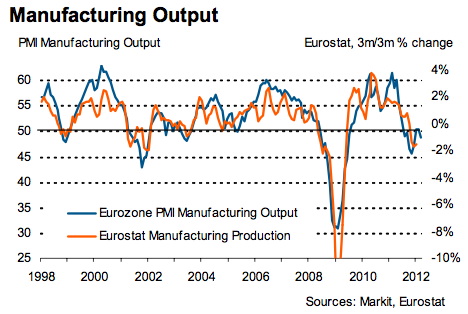
The headline Purchasing Managers’ Index® (PMI®) – a seasonally adjusted index designed to measure the performance of the manufacturing economy – dropped from 50.0 in February to 46.7 in March. The final reading was weaker than the initial flash print of 47.6 and the lowest for 33 months.
The PMI was dragged lower by four of its five components in March, namely output, new orders, employment and stocks of purchases, which all fell on the month. The final constituent, supplier delivery times, had the same influence on the PMI as in February.
Production at French manufacturers showed a renewed decline in March following February’s slight increase
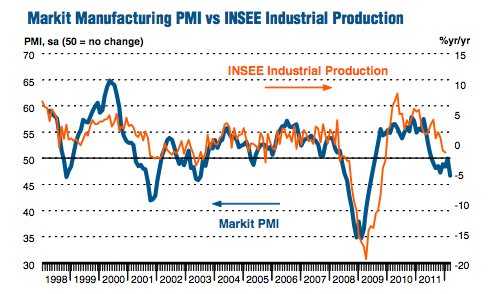
The seasonally adjusted Markit/BME Germany Purchasing Managers’ Index® (PMI®) dipped back below the neutral 50.0 mark in March, thereby ending two months of marginal improvement. At 48.4, down from 50.2 in February, the index pointed to a moderate deterioration in overall operating conditions, and was the lowest since December 2011. Moreover, March’s PMI reading was six index points lower than the average for 2011 (54.8). The output and new orders components of the headline index have both moderated substantially since their highs at the beginning of last year. By sector, investment goods producers have seen the biggest slowdown compared with the rates of growth registered in early 2011
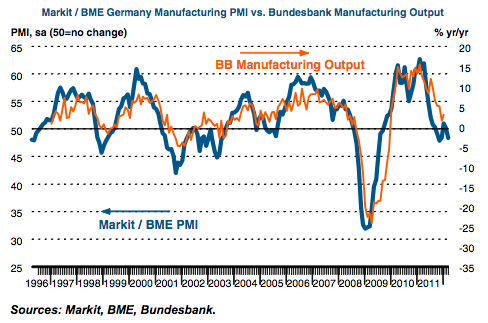
Operating conditions in the Greek manufacturing sector remained extremely challenging in March, with the headline Purchasing Managers’ Index® (PMI®) – a composite indicator designed to provide a single-figure snapshot of the performance of the manufacturing economy – again posting well below the 50.0 no-change mark. Despite improving on February’s survey low of 37.7, March’s PMI reading of 41.3 was indicative of sharp manufacturing retrenchment.
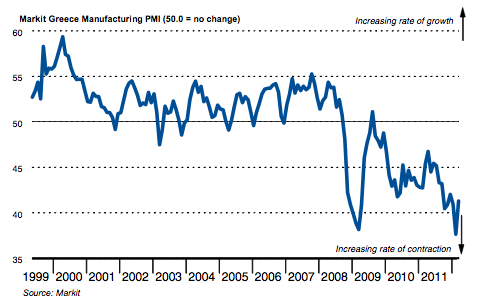
Business conditions within the Italian manufacturing sector deteriorated further during March, with output, new orders and employment each falling over the month. Weakness in the sector was highlighted by an accumulation of finished goods – the first since last October – and a marked and accelerated decrease in outstanding business.
At 47.9 in March, the seasonally adjusted Markit/ADACI Purchasing Managers’ Index® (PMI®) – a composite indicator designed to provide a single-figure snapshot of manufacturing performance – was broadly unchanged from February’s posting of 47.8, thereby signalling an eighth straight monthly decrease in overall operating conditions facing Italian manufacturers.
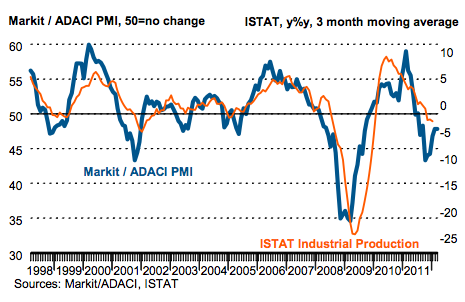
The seasonally adjusted Markit Purchasing Managers’ Index® (PMI®) – a composite indicator designed to measure the performance of the manufacturing economy – fell for the second month running, posting 44.5 in March, from 45.0 in February. Operating conditions have now worsened in each of the past 11 months, and the latest deterioration was the strongest seen in 2012 to date.
March data manufacturing sector fell further into contractionary territory during the month as both output and new orders declined at faster rates. Input prices rose sharply for the second consecutive month, but a combination of strong competition and weak demand led firms to lower their output charges again.
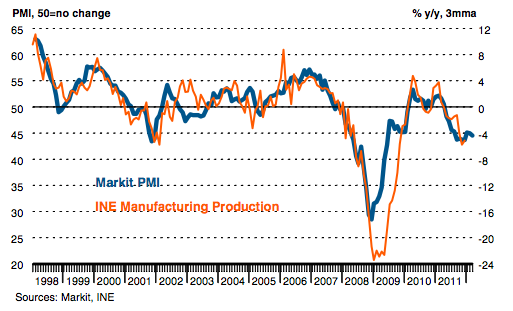
The Irish manufacturing sector ended the first quarter of 2012 on a positive note, with output, new orders and employment all rising during the month. Meanwhile, cost inflation accelerated further in March amid high oil prices.
The seasonally adjusted NCB Purchasing Managers’ Index® (PMI®) – an indicator designed to provide a single figure measure of the health of the manufacturing industry – posted 51.5 in March, rising back above the 50.0 no-change mark following the reading of 49.7 in February. Although only slight, the improvement in operating conditions was the first in the past five months.
Irish manufacturing firms recorded a solid increase in new orders, with respondents reporting that the introduction of new products had helped to boost demand. A number of panellists signalled growth of new export orders. New business from abroad increased markedly, and at the sharpest pace since May 2011
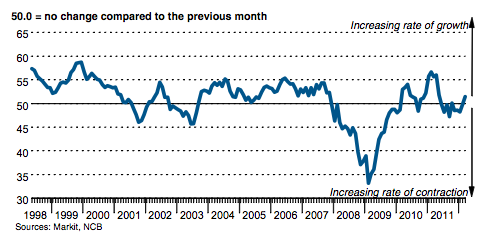
European Unemployment
Unemployment across the EuroZone was up again in February to 10.8%, 0.1% higher than January and the highest since the currency began in 1999. As usual the overall figure hides the imbalances as the following chart shows.
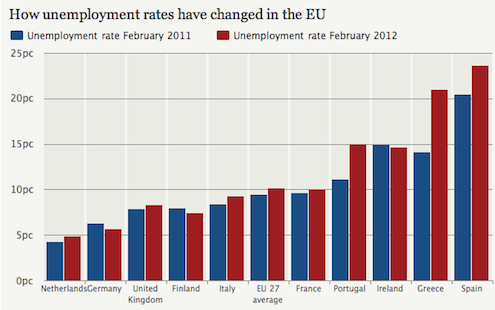
Those imbalances become even more extreme if you breakdown the data into demographic categories.
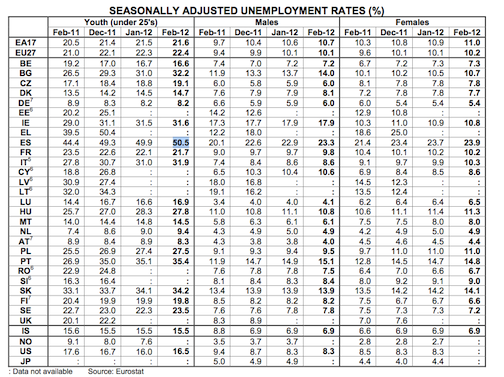
So is that a chart representing a lost generation across southern Europe ? As I have stated previously
One of my greatest concerns is that there are now literally millions of bored, unemployed and socially disenfranchised youths across southern Europe. These numbers will continue to grow as the mix of government austerity and deflating private sector economics pushes down periphery GDP and the chart below clearly shows, once again, the separation of the European periphery from the core.
Obviously this is an economic disaster and I have been at the front of the queue screaming about misguided economic ideologies in Europe that have led, and continue to lead, to this situation. However, it doesn’t take much of an imagination to realise that this has the potential to become something much more sinister than just ugly looking charts and that is my real concern.
Obviously nothing has changed in that regard.